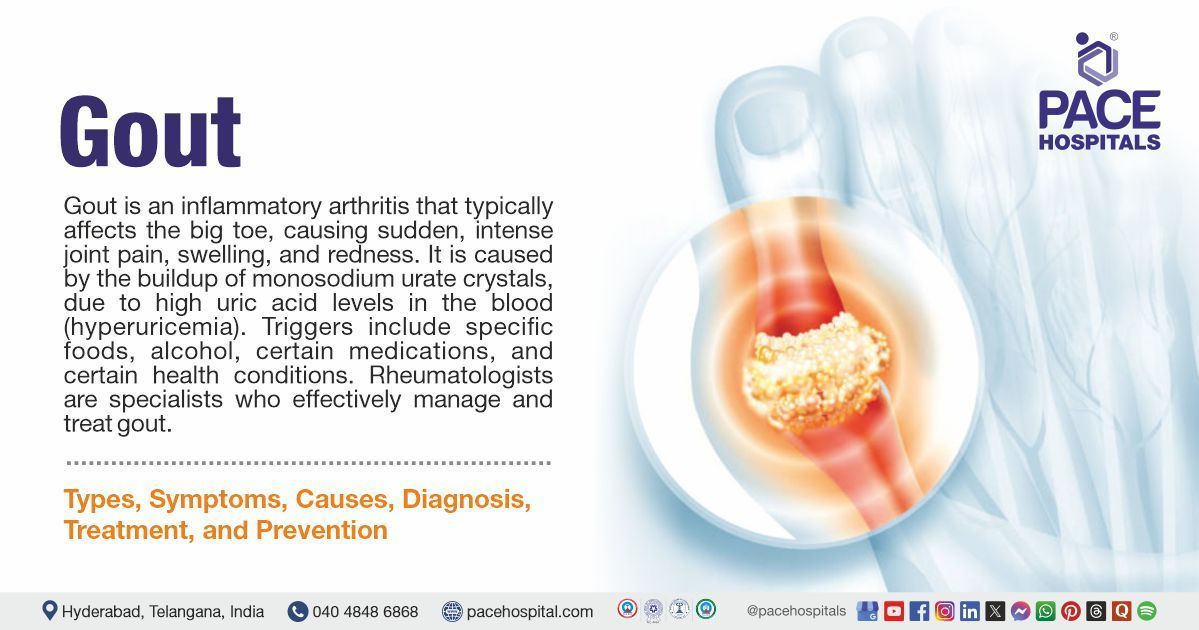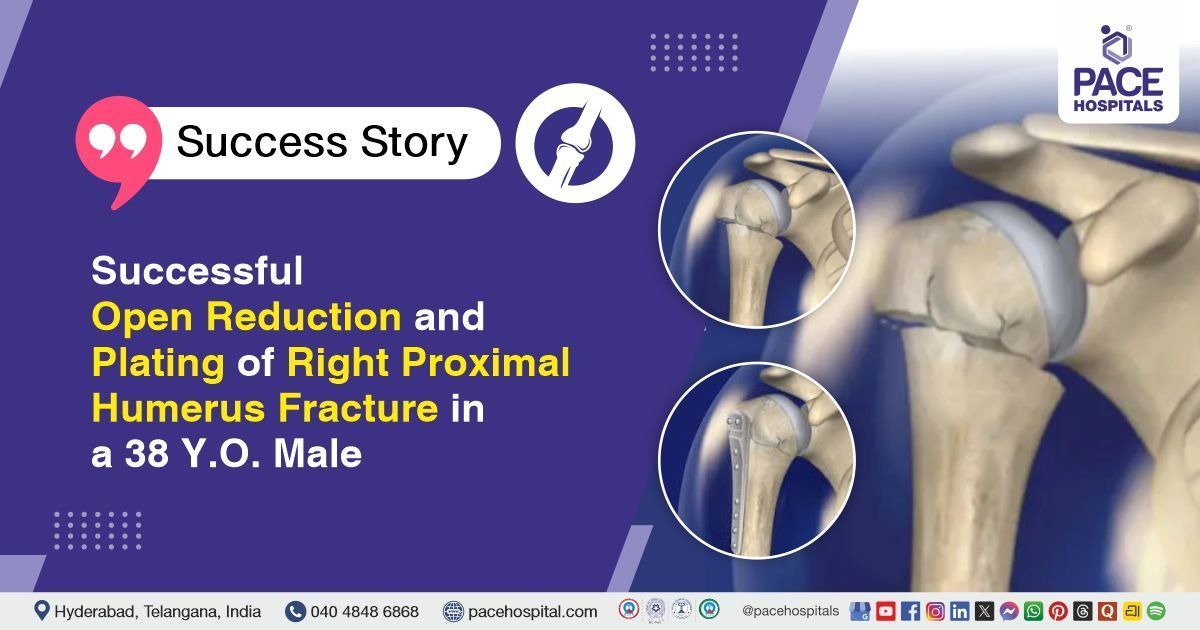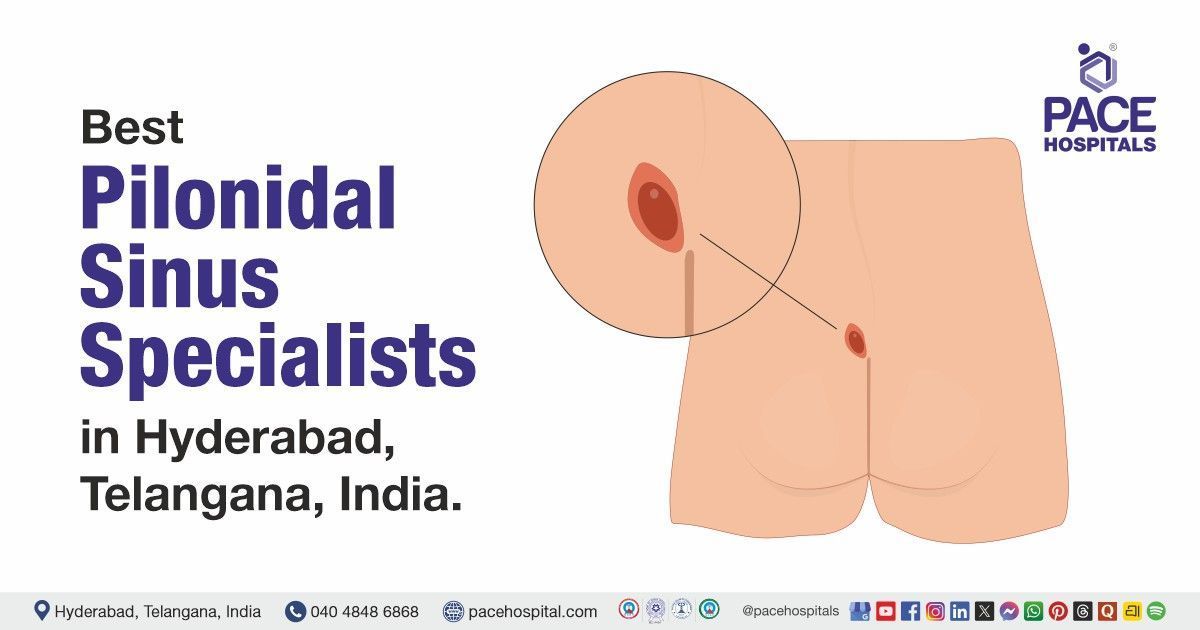Gout – Symptoms, Causes, Diagnosis, Treatment & Prevention
PACE Hospitals
Gout definition
Gout is defined as an inflammatory form of arthritis characterised by sudden and severe episodes of joint pain, swelling, and redness, most commonly affecting the big toe joint. The condition arises from the deposition of monosodium urate (MSU) crystals within the joints, resulting from sustained hyperuricemia (elevated serum uric acid levels). These crystal deposits elicit acute inflammation and severe discomfort. Various factors, including dietary habits, alcohol consumption, certain medications, or underlying health conditions, can trigger gout attacks. Rheumatologists are specialists who effectively manage and treat gout.
Gout meaning
The term "gout" dates back to around the 13th century and is derived from the Old French word “gote”, meaning "a drop" or "bead," which itself derives from the Latin word “gutta”. In medieval medicine, gout was believed to result from drops of thick bodily fluids(humor) leaking from blood into joints, a concept that closely parallels the modern understanding of uric acid crystal accumulation.
Gout Prevalence
Prevalence of gout in the world
In 2020, about 5.58 crore people worldwide had gout, with an age-standardized prevalence of 659.3 cases per 100,000 people, a 22.5% increase since 1990. Gout was over three times more common in men than in women and became more frequent with age. By 2050, the number of people with gout is expected to increase to nearly 9.6 crore, primarily due to population growth, while the global prevalence rate is predicted to remain roughly the same at 667 cases per 100,000 people.
Prevalence of gout in India
Gout prevalence in India is relatively low compared to several Western countries, with estimates around 0.12%. Despite this lower overall prevalence, gout is the most common form of inflammatory arthritis among Indian men. The incidence of gout in India is rising, likely due to factors such as increasing life expectancy, higher income levels, and a growing prevalence of associated conditions like obesity, hypertension, and metabolic syndrome.
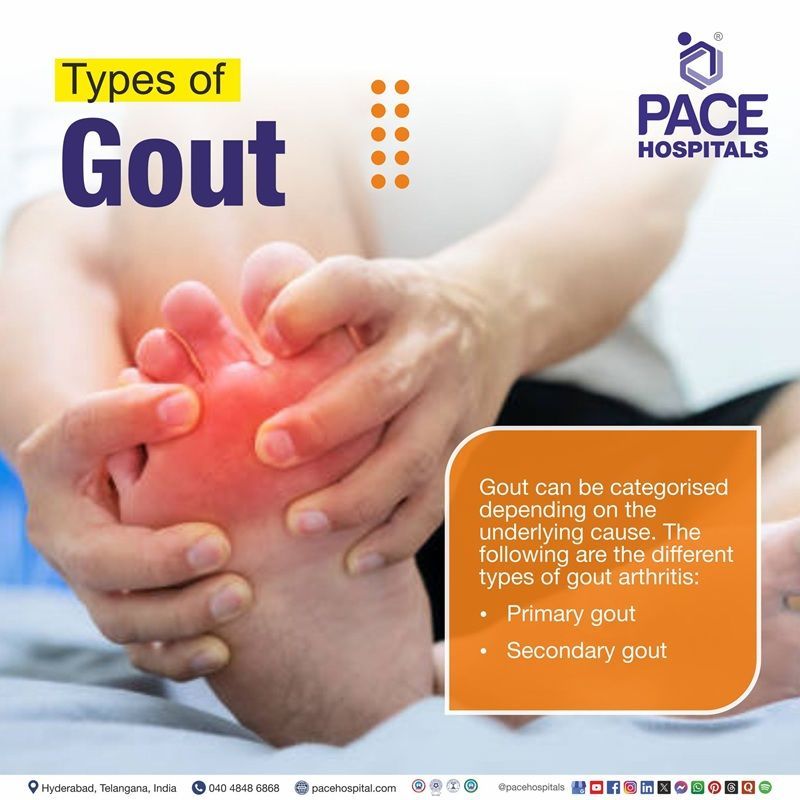
Types of Gout
Gout can be categorized as primary and secondary, depending on the underlying cause. The following are the different types of gout arthritis:
- Primary gout
- Secondary gout
Primary gout
- It refers to gout that develops as a result of inherent metabolic abnormalities, usually of genetic origin, which lead to either excessive production or impaired excretion of uric acid.
- Etiology: Most cases are idiopathic, which means they have no known external origin. Lifestyle factors, including food and genetic susceptibility, may play a role.
Secondary gout
- It refers to gout that develops as a result of another underlying medical condition or as a side effect of certain medications.
- Etiology: Common causes include
chronic kidney disease, hypertension, Lead poisoning, Hyperproliferative skin disorders, or the use of diuretics, which affect uric acid metabolism and excretion.
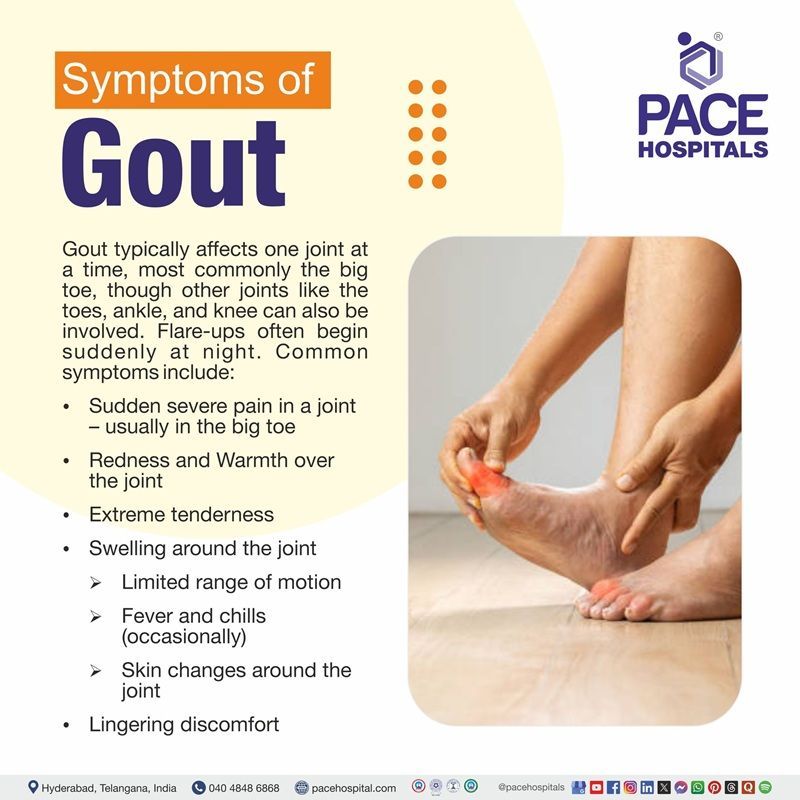
Gout Symptoms
Typically, gout only affects one joint at a time. Although the big toe (first metatarsophalangeal joint) is frequently affected, other joints, such as the toes, ankle, and knee, may also be impacted. Gout flare-up symptoms often occur suddenly at night. The following are the signs and symptoms of gout:
- Sudden severe pain in a joint – usually in the big toe (often waking the person from sleep)
- Redness and Warmth over the joint
- Extreme tenderness (even the weight of a bed sheet can be intolerable)
- Swelling around the joint
- Limited range of motion
- Fever and chills (occasionally)
- Skin changes around the joint
- Lingering discomfort can persist for days to weeks after the most intense pain subsides
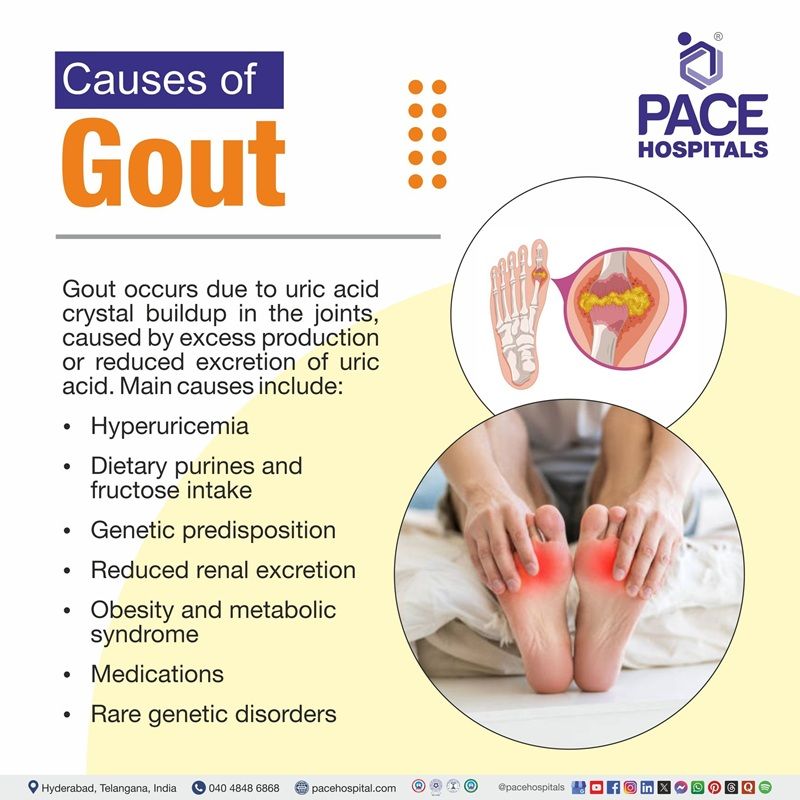
Gout Causes
The buildup of urate (uric acid) crystals in the joints leads to gout, characterised by pain and inflammation. The body produces more uric acid or excretes little of it, which leads to this accumulation. The following are the main reasons for gout:
- Hyperuricemia: Elevated serum uric acid leading to monosodium urate crystal deposition in joints and tissues is the central cause of gout. Humans lack the enzyme uricase, which converts uric acid to allantoin, resulting in higher uric acid levels.
- Dietary purines and fructose intake: Consuming foods high in purines (such as red meat and seafood), drinking alcohol (especially beer), and sugar-sweetened beverages can raise uric acid levels.
- Genetic predisposition: Family history and certain genetic factors may increase susceptibility to gout.
- Reduced Renal Excretion: Kidney impairment or genetic defects reduce uric acid excretion, leading to accumulation.
- Obesity and metabolic syndrome: Being overweight or having metabolic syndrome includes hypertension (high blood pressure), abnormal cholesterol, high blood sugar, and excess fat, which increases risk.
- Medications: Diuretics, low-dose non-selective cyclooxygenase (COX) inhibitors, immunosuppressants, antilipemic agents (administered in large doses), and certain drugs used for organ transplantation or hypertension can impair uric acid excretion.
- Rare genetic disorders: Conditions such as Lesch-Nyhan syndrome, Kelley-Seegmiller syndrome, and von Gierke disease can lead to the overproduction of uric acid.
- Other factors:
Thyroid problems, lead exposure, and organ transplantation may also contribute to gout development.
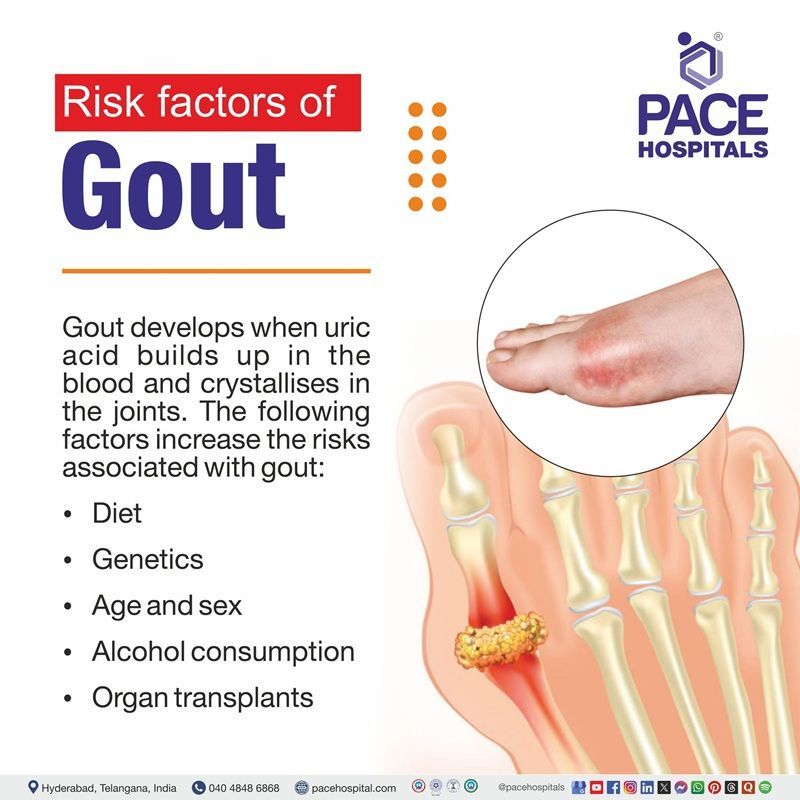
Gout Risk Factors
Gout develops when uric acid builds up in the blood and crystallises in the joints. The following factors increase the risks associated with gout:
- Diet: Consumption of foods high in purines (often derived from animals), a chemical that decomposes into urate, and an unhealthy diet and seafood.
- Genetics: Having a family history may increase the chances of getting gout.
- Age and sex: Risk increases with age, and gout is more common in men.
- Alcohol consumption: Beer and spirits both increase uric acid production and decrease its excretion.
- Organ transplants: In organ transplantation, both surgery and immunosuppressive agents increase the risk of complications.
- Other factors: Chronic kidney disease, hypertension, obesity, metabolic syndrome, certain medications (e.g., diuretics), Genetic disorders, and trauma also increase the risk.
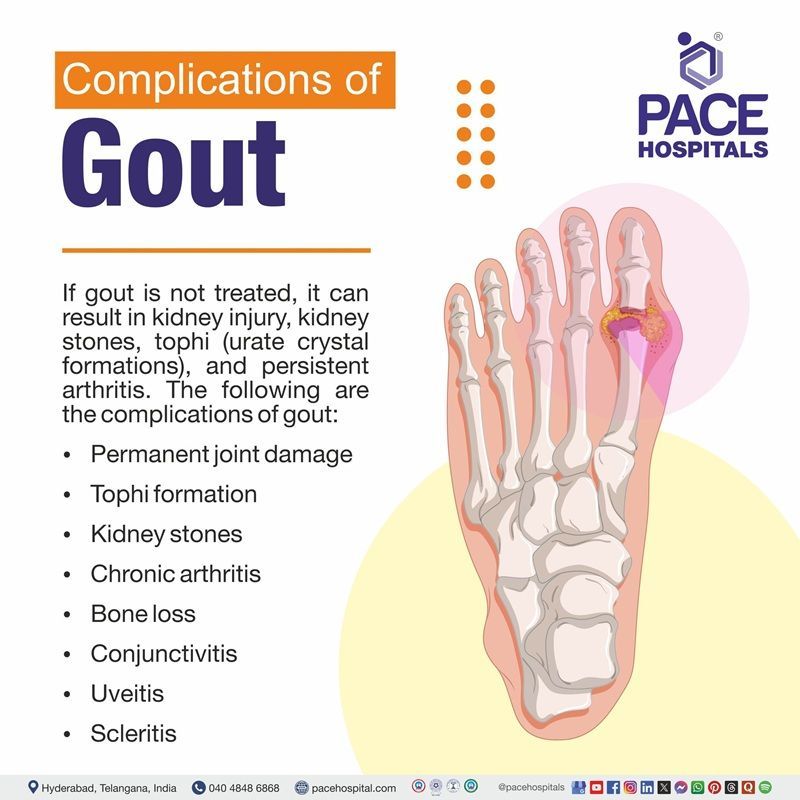
Gout Complications
If gout is not treated, it can result in kidney injury, kidney stones, tophi (urate crystal formations), and persistent arthritis. Due to discomfort, limited mobility, and possible long-term health consequences, the following are the complications of gout:
- Permanent joint damage: Chronic inflammation and frequent episodes of gout can damage the bones and cartilage of afflicted joints over time, resulting in deformity, impairment, and loss of function.
- Tophi formation: The fingers, palms, elbows, feet, and ears are popular places for tophi, which are hard deposits of urate crystals that form beneath the skin. In addition to causing discomfort and deformity, tophi can also develop into infected or compressed nerves, leading to further complications.
- Kidney stones: These kidney stones can be formed in the urinary tract when too much uric acid crystallizes, increasing the risk of kidney infections and causing discomfort and blockage.
- Chronic arthritis: Prolonged joint inflammation, stiffness, and deformity brought on by chronic gout can impair mobility and quality of life.
- Bone loss: It can occur in chronic gout due to ongoing inflammation and urate crystal deposits, leading to joint damage and reduced bone density.
- Conjunctivitis: It may rarely occur as a complication of gout due to urate crystal deposition or associated inflammation in ocular tissues. It can cause eye redness, irritation, and discomfort.
- Uveitis: It is a rare complication of gout caused by urate crystal deposition or systemic inflammation, leading to inflammation of the uveal tract. It can present with eye pain, redness, blurred vision, and light sensitivity.
- Scleritis: It is a rare gout-related complication marked by scleral inflammation from urate crystal deposits, causing eye pain, redness, and potential vision issues.
Gout Diagnosis
The usual method for diagnosing gout involves evaluating symptoms, inspecting affected joints, and performing specific tests. The gold standard for diagnosis is the use of microscopy to detect monosodium urate crystals in joint fluid, which is frequently acquired after a flare-up. The following are the steps commonly included in the diagnostic process for gout:
- Medical history and prior history of gout
- Physical examination
- Synovial (joint) fluid analysis
- Laboratory tests (Blood test, Urine test)
- Imaging tests (X-rays,
Ultrasound, Dual-energy computed tomography (DECT))
Gout Treatment
Gout treatment focuses on different goals depending on the phase of the disease. During acute flares, the priority is to reduce inflammation and relieve symptoms. Long-term management aims to lower serum urate levels to prevent future flares and shrink tophi. Below are the treatment options for gout:
- Nonpharmacological treatment
- Pharmacological treatment
- Acute gout flare
- Nonsteroidal anti-inflammatory drugs (NSAIDs)
- Mitotic inhibitor and anti-inflammatory alkaloid
- Corticosteroids
- Interleukin-1 antagonist
- Chronic gout (Preventing future attacks and complications)
- Xanthine oxidase inhibitors (XOI)
- Uricosuric Drugs
- Recombinant uricase agents
- Surgical procedures
- Tophectomy (Tophi removal)
Why Choose PACE Hospitals?
Expert Super Specialist Doctors
Advanced Diagnostics & Treatment
Affordable & Transparent Care
24x7 Emergency & ICU Support
Gout Prevention
Gout can be effectively managed and prevented through various strategies. Lifestyle modifications play an important role in reducing the frequency of flares and managing symptoms. They include:
- Weight loss: Particularly for those who are overweight or obese, weight loss through a lower-calorie diet and consistent exercise can help lower serum urate levels and lessen the frequency of gout flare-ups.
- Dietary changes: Limiting alcohol (including nonalcoholic beer), avoiding sugar-sweetened beverages, and reducing intake of red and organ meats, as well as certain seafood such as shellfish, sardines, and anchovies, can help lower purine intake and reduce the risk of gout.
- Dietary approaches to Stop Hypertension (DASH) diet: It is particularly beneficial in hypertensive patients. The DASH eating plan includes: A healthy gout-friendly diet such as plenty of vegetables, fruits, and whole grains, low-fat or fat-free dairy, lean poultry and healthy oils while limiting saturated fats and sugar-sweetened foods and beverages.
- Ice application: Applying ice to the affected area can help reduce both swelling and pain by numbing the tissues and constricting blood vessels. It is recommended to use an ice pack wrapped in a cloth and apply it for 15 to 20 minutes at a time to avoid skin damage.
- Limb elevation: By elevating the affected limb above heart level, if possible, it helps decrease blood flow to the area, which can reduce swelling and promote faster healing.
- Rest:
Resting the affected joint is essential to prevent further irritation and allow the inflammation to subside. Avoid putting weight or strain on the joint to promote healing and reduce pain during flare-ups.
Difference between Gout and Rheumatoid Arthritis
Gout vs rheumatoid arthritis
Gout and
rheumatoid arthritis are both joint diseases but differ in cause, symptoms, and treatment. Below are some of the parameters that help in differentiating gout and rheumatoid arthritis:
| Parameters | Gastric outlet obstructions | Gastroparesis |
|---|---|---|
| Definition | Gout is a type of inflammatory arthritis that usually affects the big toe and is brought on by the deposition of uric acid crystals in the joints. It frequently causes abrupt, severe pain and swelling. | The body's immune system unintentionally targets the synovial lining of the joints in RA, a chronic autoimmune disease, causing inflammation, discomfort, and joint destruction. |
| Cause | Urate crystals that accumulate in the joints are the result of an overabundance of uric acid in the blood. | An autoimmune disease in which the synovium (the lining around joints) is specifically targeted by the immune system. |
| Affected joints | Mostly affects the big toe, while it can also affect other joints, usually one-sidedly, such as the knees, elbows, and ankles. | Smaller joints, like those in the hands, wrists, and feet, are most frequently affected, frequently in a symmetrical pattern. |
| Pain Pattern | Usually beginning overnight or early in the morning, pain is abrupt, acute, and severe. There may be redness, swelling, and heat in the afflicted joint. | Usually, chronic pain can flare up and then subside for a while. Particularly in the morning, the discomfort is frequently dull and painful with stiffness. |
Difference between Gout and Arthritis
Gout vs arthritis
Gout is a specific form of arthritis caused by uric acid crystal buildup in the joints. Arthritis is a broad term for joint inflammation that includes many different types. Here is a brief comparison between gout and arthritis are:
| Parameters | Gastric outlet obstructions | Gastroparesis |
|---|---|---|
| Definition | Gout is a type of inflammatory arthritis that usually affects the big toe and is brought on by the deposition of uric acid crystals in the joints. It frequently causes abrupt, severe pain and swelling. | Arthritis is a disease defined by inflammation and pain in one or more joints. |
| Symptoms | Characterized by abrupt, intense flare-ups of warmth, redness, swelling, and pain in the afflicted joint, which is frequently the big toe. | Although there are many different symptoms, joint pain, edema, stiffness and reduced range of motion are common ones. Depending on the type of arthritis, symptoms may be episodic or persistent. |
| Treatment | Treated with anti-inflammatory drugs during episodes, uric acid-lowering medications, and lifestyle modifications to avoid recurrences | Depending on the type, treatment may involve physical therapy, anti-inflammatory medications, painkillers, lifestyle modifications, and occasional surgery. |
Frequently Asked Questions (FAQs) on Gout
Is gout an autoimmune disease?
No, gout is not an autoimmune condition, to be clear. This type of arthritis is caused by an accumulation of uric acid in the blood, resulting in the formation of uric acid crystals in the joints, leading to pain and inflammation.
How to treat gout?
Gout is managed through a combination of medications and lifestyle modifications. During acute attacks, anti-inflammatory drugs are used to relieve pain and inflammation. Long-term treatment focuses on urate-lowering therapy (ULT) to reduce serum uric acid levels, along with dietary and lifestyle changes to prevent future flare-ups and complications.
Which doctor to consult for gout?
For gout, the most appropriate doctor to consult is a rheumatologist, who is trained in diagnosing and treating arthritis and other conditions affecting the joints, muscles, and bones. Primary care physicians, such as internists, can also manage gout, particularly in its initial stages or when it is well-controlled. In cases of severe gout or when joint damage is present, referral to a rheumatologist is recommended for more specialized care and management.
How to relieve gout pain without medication?
Gout pain can be relieved without medication by adopting lifestyle and home remedies. Effective approaches include resting the affected joint, applying ice, elevating the joint, and making dietary changes to lower uric acid levels. Staying well-hydrated and managing stress also contributes to symptom relief.
How to remove gout crystals from a joint?
Effective gout treatment focuses on lowering uric acid levels in the body, that gradually leads to the natural dissolution of uric acid crystals in the joints. These crystals cannot be directly removed, but with appropriate medication, lifestyle changes, and adequate hydration, uric acid levels can be reduced, promoting the gradual clearance of the crystals.
Why is obesity a risk for gout?
Being obese increases the chance of developing gout, mainly because it is linked to hyperuricemia or high blood uric acid levels. In addition to increasing uric acid synthesis, it also helps the kidneys excrete less of it. The kidneys' capacity to effectively remove uric acid is compromised by insulin resistance, which is often associated with obesity.
Can you have gout with normal uric acid levels?
Yes, gout symptoms can occur even when blood uric acid levels are in the normal range. Although hyperuricemia is a key risk factor for gout, some individuals may experience gout attacks despite having normal uric acid levels, while others with elevated levels may never develop symptoms. This can be due to fluctuations in uric acid concentration within the joints, individual susceptibility, or other underlying health factors that influence crystal formation.
Can gout be cured permanently?
Gout cannot be permanently cured, but it can be effectively managed with appropriate treatment and management. Although the underlying cause of excess uric acid in the blood cannot be eliminated, a combination of medications and lifestyle modifications can control symptoms, reduce the frequency of attacks, and minimize long-term complications.
What is chronic gout?
Chronic gout is a long-term form of gout, a type of arthritis marked by recurring and persistent joint pain and inflammation caused by the buildup of uric acid crystals. It typically develops when gout is not effectively managed, leading to repeated flare-ups and an increased risk of joint damage over time.
Is gout hereditary?
Yes , Genetics plays a major part in the development of gout, which has a hereditary component and may run in families. However, the risk can also be raised by lifestyle variables, including obesity, a diet heavy in purines, and medical diseases like diabetes or high blood pressure. By controlling these variables with a healthy diet and medicine, gout risk can be decreased.
How to reduce gout pain?
To reduce pain, patients need to take any prescribed medication as soon as possible, as it needs to begin to provide relief within two days. To further alleviate pain, rest and elevate the affected limb. Keeping the joint cool by applying an ice pack or a towel-wrapped bag of frozen peas for up to 20 minutes at a time is advised. It's important to stay well-hydrated by drinking plenty of water. Lastly, patients need to try to keep bedclothes off the affected joint at night to prevent additional pressure or discomfort.
What is a gout attack?
A gout attack, or gout flare, is a sudden and excruciating pain in a joint, typically affecting the big toe. It causes uric acid crystals to accumulate in the joint fluid, prompting an immune response that causes inflammation.
Can gout be cured by surgery?
Surgery is not always the first-line treatment for gout. Still, it may be considered in severe cases, especially when there is significant joint damage or the presence of tophi (deposits of uric acid crystals). In most instances, gout is managed effectively through medication and lifestyle adjustments.
How do you diagnose gout?
Gout is commonly diagnosed through a combination of physical examination, medical history, and laboratory tests. The most reliable method is identifying urate crystals in the joint fluid, though blood tests and imaging studies can also provide valuable information for diagnosis.
When to consult a doctor for gout?
Consult a doctor for gout if joint pain and swelling occur suddenly, especially in the big toe, ankle, or knee, and do not improve within a few days. Signs that need medical attention include:
- Sudden, intense joint pain (especially at night)
- Redness, warmth, and swelling in a joint
- Difficulty moving the affected joint
- Recurrent attacks of joint pain
- Pain that interferes with daily activities or sleep
- Fever or chills with joint pain (could indicate infection)
If these symptoms persist or worsen, it is important to see a gout specialist or rheumatologist who can confirm the diagnosis through tests and recommend appropriate treatment to prevent joint damage and future attacks. Seek emergency medical care if you experience severe joint swelling with fever, as this may signal a joint infection. A primary care physician or rheumatologist can provide the best gout treatment effectively and reduce the risk of complications.
Share on
Request an appointment
Fill in the appointment form or call us instantly to book a confirmed appointment with our super specialist at 04048486868

